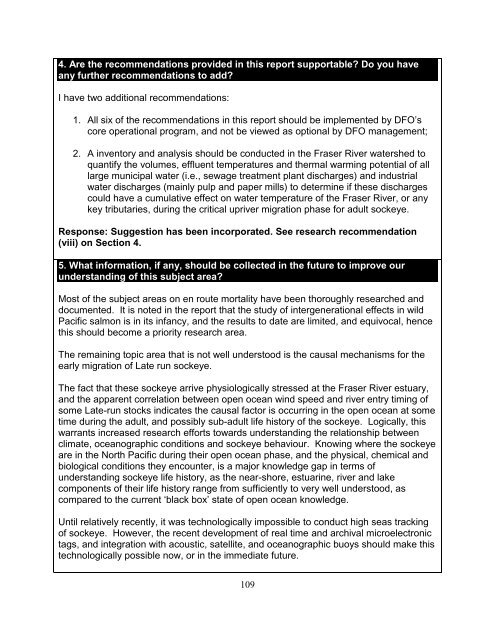Climate Change - Cohen Commission
Climate Change - Cohen Commission
Climate Change - Cohen Commission
You also want an ePaper? Increase the reach of your titles
YUMPU automatically turns print PDFs into web optimized ePapers that Google loves.
4. Are the recommendations provided in this report supportable? Do you have<br />
any further recommendations to add?<br />
I have two additional recommendations:<br />
1. All six of the recommendations in this report should be implemented by DFO‟s<br />
core operational program, and not be viewed as optional by DFO management;<br />
2. A inventory and analysis should be conducted in the Fraser River watershed to<br />
quantify the volumes, effluent temperatures and thermal warming potential of all<br />
large municipal water (i.e., sewage treatment plant discharges) and industrial<br />
water discharges (mainly pulp and paper mills) to determine if these discharges<br />
could have a cumulative effect on water temperature of the Fraser River, or any<br />
key tributaries, during the critical upriver migration phase for adult sockeye.<br />
Response: Suggestion has been incorporated. See research recommendation<br />
(viii) on Section 4.<br />
5. What information, if any, should be collected in the future to improve our<br />
understanding of this subject area?<br />
Most of the subject areas on en route mortality have been thoroughly researched and<br />
documented. It is noted in the report that the study of intergenerational effects in wild<br />
Pacific salmon is in its infancy, and the results to date are limited, and equivocal, hence<br />
this should become a priority research area.<br />
The remaining topic area that is not well understood is the causal mechanisms for the<br />
early migration of Late run sockeye.<br />
The fact that these sockeye arrive physiologically stressed at the Fraser River estuary,<br />
and the apparent correlation between open ocean wind speed and river entry timing of<br />
some Late-run stocks indicates the causal factor is occurring in the open ocean at some<br />
time during the adult, and possibly sub-adult life history of the sockeye. Logically, this<br />
warrants increased research efforts towards understanding the relationship between<br />
climate, oceanographic conditions and sockeye behaviour. Knowing where the sockeye<br />
are in the North Pacific during their open ocean phase, and the physical, chemical and<br />
biological conditions they encounter, is a major knowledge gap in terms of<br />
understanding sockeye life history, as the near-shore, estuarine, river and lake<br />
components of their life history range from sufficiently to very well understood, as<br />
compared to the current „black box‟ state of open ocean knowledge.<br />
Until relatively recently, it was technologically impossible to conduct high seas tracking<br />
of sockeye. However, the recent development of real time and archival microelectronic<br />
tags, and integration with acoustic, satellite, and oceanographic buoys should make this<br />
technologically possible now, or in the immediate future.<br />
109

















